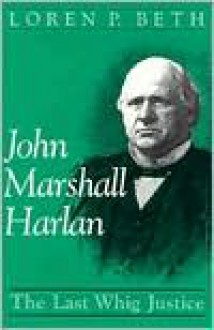
Though often a lone dissenter from the prevailing legal thought of his time, the reputation of John Marshall Harlan has enjoyed considerable rehabilitation since his death. Best known for his criticism of the Plessy v. Ferguson decision, his opinions in that and other cases have come to be seen by many legal scholars as precursors to the liberal jurisprudence of the twentieth century. Capping this new appreciation of Harlan’s work was Loren P. Beth’s biography of the Supreme Court justice, which offers an examination of both Harlan’s life and his jurisprudence.
Beth divides his analysis into three parts. The first two are biographical and chronological, examining his life both before and on the Court. Much of the information about his life before his selection to the court comes from reminisces written by Harlan and his wife Malvina, and Beth often includes large sections from them in his text. The Harlan that emerges in these pages is an extremely political man, one who was active in the dramatic struggles of mid-19th century politics. Starting as a Whig, he drifted in the unstable Kentucky party political environment before finally becoming a Republican in 1868. Though unsuccessful in two campaigns for the governorship of Kentucky, Harlan’s efforts on behalf of the party in his state helped make him a national political figure, leading to his nomination to the Court in 1877.
The second part of the book, which looks at Harlan’s family life, his relationships with his justices, and his role in the politics surrounding the Court, serves as a useful bridge to the final section, which addresses his jurisprudence. Here Beth analyzes his decisions by topic, grouping them into categories so as to identify the underlying legal philosophy that collectively they reveal. While these chapters are informative, they do not succeed in Beth’s goal, as illustrated by his subtitle, of demonstrating that Harlan’s decisions reflected Whig political ideology, nor does the author reconcile the many inconsistencies and contradictions that existed between the Harlan’s life and his jurisprudence. This, along with the poor editing (there are numerous minor factual errors throughout the book, particularly regarding dates), make for the book that is a useful introduction to Harlan’s life but not the thorough analytical study that the justice deserves.

 Log in with Facebook
Log in with Facebook 









